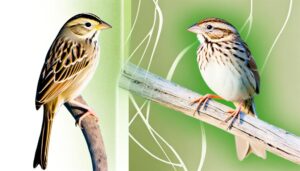Botteri Vs Cassins Sparrow: Key Differences and Comparison
Botteri’s and Cassin’s Sparrows possess distinct characteristics. Botteri’s Sparrow exhibits a dull gray-brown color with subtle streaking, while Cassin’s Sparrow features pronounced facial markings and clear wing bars.
Botteri’s Sparrow’s song is a subdued, repetitive chant, contrasting with Cassin’s Sparrow’s melodious trills. Nesting habits differ, with Botteri’s opting for ground nests cloaked in grasses, and Cassin’s choosing elevated shrub nests.
Concerning habitat, Botteri’s prefers dense grasslands, whereas Cassin’s thrives in arid shrublands. Their feeding behaviors vary, with Botteri’s foraging on the ground and Cassin’s adopting an opportunistic approach.
For more about their ecology and conservation status, continue below.

Key Takeaways
- Botteri’s Sparrow has a uniformly dull gray-brown color, while Cassin’s Sparrow has distinct streaking and pronounced facial markings.
- Botteri’s Sparrow sings a subdued, repetitive chant, whereas Cassin’s Sparrow’s song includes melodious trills and buzzes.
- Botteri’s Sparrow nests on the ground in dense grasslands; Cassin’s Sparrow nests in shrubs and performs flight displays.
- Botteri’s Sparrow primarily inhabits dense grasslands in Mexico and the southwestern U.S., while Cassin’s Sparrow prefers arid shrublands and semi-deserts.
- Botteri’s Sparrow has minimal migratory movement, but Cassin’s Sparrow shows partial seasonal migration southward during winter.
9 Aspects: Botteri’s Sparrow vs. Cassin’s Sparrow
| Aspect | Botteri’s Sparrow | Cassin’s Sparrow |
|---|---|---|
| Scientific Name | Peucaea botterii | Peucaea cassinii |
| Size | 6 inches (15 cm) | 5.5 inches (14 cm) |
| Plumage | Dull brown upperparts with pale underparts and faint streaking | Grayish-brown upperparts with a more defined facial pattern |
| Habitat | Prefers grasslands with scattered shrubs, often in areas with tall, dense grass | Found in dry prairies, open scrublands, and desert areas |
| Range | Southern Texas, Mexico, and parts of Central America | Southwestern U.S. including Texas, Arizona, and New Mexico |
| Song | A dry, insect-like trill with few variations | A distinctive, musical trill followed by varied notes |
| Breeding Behavior | Nests on the ground in grassy or shrubby areas | Builds nests close to the ground in open grassland or scrub |
| Diet | Primarily seeds, with some insects during breeding season | Feeds mainly on seeds and insects, especially grasshoppers |
| Conservation Status | Least Concern, but localized declines due to habitat loss | Least Concern, but also faces habitat degradation issues |
Physical Appearance

Botteri’s Sparrow and Cassin’s Sparrow exhibit distinct differences in their physical appearance, essential for accurate identification. Botteri’s Sparrow is generally more uniformly dull gray-brown in color, with a subtle, indistinct streaking on the breast and back.
In contrast, Cassin’s Sparrow displays a more pronounced, crisp streaking pattern on its crown, nape, and back, giving it a slightly more patterned look. The facial markings also differ; Botteri’s Sparrow has a less defined facial pattern, while Cassin’s Sparrow shows a clearer, more contrasting eye stripe and malar stripe.
Wing coloration plays a role too—Botteri’s Sparrow has plainer wings, whereas Cassin’s Sparrow exhibits more evident wing bars. These morphological distinctions are critical for ornithologists and bird enthusiasts aiming to differentiate these species in the field.
Vocalizations
Botteri’s and Cassin’s Sparrows exhibit distinct vocalizations, characterized by differences in pitch, rhythm, and complexity.
Seasonal variations in singing behavior highlight adaptive responses to breeding cycles.
In addition, habitat differences greatly influence call structures, with each species exhibiting unique acoustic properties in response to their respective environments.
Song Characteristics Comparison
Comparing the vocalizations of Botteri’s and Cassin’s Sparrows reveals distinct differences in their song structures and patterns. Botteri’s Sparrow employs a more subdued and repetitive chant, often described as a series of ‘chip’ notes, which can be monotonous.
In contrast, Cassin’s Sparrow showcases a more melodious and varied song, incorporating a blend of musical trills and buzzes.
Key distinctions include:
- Song complexity: Botteri’s songs are simpler, whereas Cassin’s are more elaborate.
- Frequency range: Cassin’s songs span a broader frequency range, making them more dynamic.
- Pacing: Botteri’s Sparrow’s songs have a steadier, slower rhythm compared to the more varied tempo of Cassin’s Sparrow.
These characteristics highlight the unique vocal identities of each species, reflecting their ecological adaptations.
Seasonal Singing Differences
Shifting focus from the structural differences in their songs, one observes that both sparrows exhibit notable variations in their vocalizations linked to seasonal changes.
Botteri’s Sparrow increases song frequency during the breeding season, utilizing a repetitive, monotonous pattern to attract mates and establish territory.
In contrast, Cassin’s Sparrow displays a more complex vocal repertoire, incorporating flight songs and ground-based calls that vary with seasonal changes.
During non-breeding periods, both species reduce their singing activity significantly, conserving energy for survival rather than courtship.
This seasonal modulation indicates adaptive behaviors aimed at optimizing reproductive success and resource allocation.
Detailed spectrographic analysis reveals these temporal shifts, highlighting the intricate relationship between environmental cues and avian vocalization patterns.
Habitat Influence on Calls
Variations in habitat structure and vegetation density significantly influence the vocalization patterns of both Botteri’s and Cassin’s Sparrows. In open grasslands, Botteri’s Sparrow exhibits prolonged, melodious calls that travel extensive distances. Conversely, dense shrublands prompt Cassin’s Sparrow to produce shorter, sharper notes to navigate through thick foliage. These adaptations guarantee effective communication despite environmental constraints.
Key influences include:
- Vegetation density: Dense foliage necessitates higher-pitched, concise calls.
- Habitat openness: Open areas facilitate longer, more resonant songs.
- Acoustic properties: Vegetation alters sound propagation, affecting song frequency.
These observations illustrate how habitat intricacies dictate vocal strategies, guaranteeing these sparrows maintain effective communication channels. Understanding these nuances enhances appreciation for avian adaptability amidst diverse ecosystems.
Breeding Habits

Both Botteri’s and Cassin’s Sparrows exhibit distinct breeding habits, characterized by their unique nesting behaviors and mating rituals.
Botteri’s Sparrow constructs ground nests, meticulously camouflaged with grasses and leaves. Their courtship involves males performing flight songs to attract females.
Cassin’s Sparrow, conversely, opts for elevated nests in shrubs, ensuring safety from ground predators. Males perform a combination of flight displays and ground hopping, vocalizing to secure female attention.
Both species demonstrate territoriality, with males defending their breeding sites vigorously. Females undertake the primary role in nest building and incubation, showcasing a division of labor.
These breeding strategies underscore the adaptability and resourcefulness of each species, reflecting evolutionary responses to their respective environments.
Feeding Behavior
Botteri’s Sparrow primarily forages on the ground, meticulously searching for seeds and insects among the grasses. Its diet is composed of a balanced mixture of plant and animal matter, reflecting its adaptability and resourcefulness. Observations indicate that this sparrow employs a methodical approach, often using short, deliberate hops to uncover hidden sustenance.
Key dietary components include:
- Grass seeds: Rich in carbohydrates, essential for energy.
- Small insects: Provide pivotal proteins and fats.
- Fruits: Occasionally consumed for vitamins and minerals.
Cassins Sparrow, in contrast, displays more opportunistic feeding behavior, often incorporating a variety of arthropods and plant matter into its diet. It frequently perches on low shrubs or grasses, scanning for prey before descending with precision. This behavior highlights its flexible foraging strategies and ecological versatility.
Habitat Preferences

In their search for ideal living conditions, Botteri’s Sparrow favors open grasslands with dense vegetation, which provide ample cover and foraging opportunities. This habitat selection reflects their need for nesting sites and protection from predators. They frequently inhabit areas with tall grasses and scattered shrubs, ensuring a blend of visibility and concealment.
Conversely, Cassin’s Sparrow prefers arid shrublands and semi-desert environments. They’re often found in regions characterized by sparse vegetation, such as scattered shrubs and low grasses. These habitats cater to their ground-nesting behavior and territorial displays.
Both species exhibit highly specialized habitat preferences, which are pivotal for their survival and reproductive success. The specific environmental conditions they seek reflect their evolutionary adaptations and ecological niches.
Migration Patterns
While their habitat preferences highlight distinct ecological niches, their migration patterns further underscore the differences between Botteri’s and Cassin’s Sparrows.
Botteri’s Sparrows exhibit a relatively sedentary lifestyle, rarely venturing far from their breeding grounds in southern Arizona and northern Mexico. Conversely, Cassin’s Sparrows display more pronounced migratory behavior, traversing significant distances between their breeding territories in the southwestern United States and wintering sites in central Mexico.
Key observations include:
- Botteri’s Sparrows: Limited migratory range, mostly resident.
- Cassin’s Sparrows: Long-distance migrants, seasonal movements.
- Timing: Cassin’s migrate in late summer, Botteri’s remain mostly stationary.
These migration patterns affect their respective ecological roles and interaction with the environment, reflecting evolutionary adaptations to their distinct habitats. Understanding these patterns is important for conservation efforts and ecological studies.
Nesting Sites

Cassin’s Sparrows prefer building their nests in open grasslands with sparse shrub cover, providing a balance of concealment and accessibility. These locations offer ideal conditions for nesting success, combining safety from predators and ease of access for foraging.
In contrast, Botteri’s Sparrows usually select denser grassland habitats with more extensive vegetation cover, favoring thick grass clumps and regions with greater ground cover.
| Species | Preferred Nesting Habitat |
|---|---|
| Cassin’s Sparrow | Open grasslands, sparse shrubs |
| Botteri’s Sparrow | Dense grasslands, thick vegetation |
Cassin’s Sparrows’ nests are typically well-hidden under low shrubbery, whereas Botteri’s Sparrows construct their nests on the ground amidst dense grasses. This divergent habitat selection illustrates their adaptation strategies, ensuring survival and reproductive success in varied environmental conditions.
Geographic Range
Botteri’s Sparrow and Cassin’s Sparrow exhibit distinct habitat distribution differences and contrasting migration patterns. Botteri’s Sparrow mainly inhabits dense grasslands in Mexico and the southwestern United States, while Cassin’s Sparrow ranges across the central and southwestern United States into northern Mexico.
Additionally, Cassin’s Sparrow demonstrates partial migratory behavior, unlike the mainly resident Botteri’s Sparrow.
Habitat Distribution Differences
These two sparrow species exhibit distinct geographic distributions. Botteri’s Sparrow is mainly found in the southwestern United States and northern Mexico. It prefers semi-arid grasslands with scattered shrubs, often thriving in mesquite and sacaton grass regions. Cassin’s Sparrow, on the other hand, occupies a broader range extending from the central United States to northern Mexico. It is more adaptable, inhabiting mixed-grass prairies, shrublands, and arid desert scrub.
Both species can be found in northern Mexico, showing some geographic overlap. These habitat preferences highlight their ecological niches, influencing their distribution and survival strategies.
Migration Patterns Comparison
In examining their migration patterns, one finds that Botteri’s Sparrow exhibits minimal migratory movement, largely remaining within its breeding range, while Cassin’s Sparrow engages in more pronounced seasonal migrations, traveling to southern regions during winter.
Botteri’s Sparrow, inhabiting arid grasslands from southern Arizona to Central America, shows site fidelity, rarely venturing beyond established territories. Conversely, Cassin’s Sparrow, residing in the southwestern United States, exhibits partial migratory behavior. It relocates to Mexico and the Gulf Coast regions when temperatures drop, seeking milder climates.
This dichotomy in migratory behavior underscores the species’ adaptive strategies. Botteri’s sedentary nature contrasts with Cassin’s seasonal mobility, reflecting divergent ecological pressures and resource availability that drive their respective migratory decisions.
Conservation Status

Although both Botteri’s and Cassin’s Sparrows face habitat challenges, their conservation statuses differ due to varying degrees of habitat specialization and geographical distribution.
Botteri’s Sparrow, a habitat specialist, is more vulnerable due to its reliance on specific grassland ecosystems. Its limited range makes it susceptible to habitat degradation and climate change.
In contrast, Cassin’s Sparrow exhibits greater adaptability, occupying a broader range of arid and semi-arid habitats, which provides a buffer against environmental changes.
Key differences impacting conservation status include:
- Geographical range: Botteri’s Sparrow has a restricted range; Cassin’s Sparrow is more widespread.
- Habitat specialization: Botteri’s Sparrow is a specialist; Cassin’s Sparrow is a generalist.
- Vulnerability to changes: Botteri’s Sparrow is more affected by habitat loss and climate shifts.
Conclusion
In the grand tapestry of avian wonders, Botteri’s and Cassin’s Sparrows present a riveting study in contrasts. Their distinct physical traits, divergent vocalizations, and unique breeding habits paint a vivid picture of nature’s marvels.
Their feeding behaviors and habitat choices are as diverse as their migration journeys are intricate. These sparrows’ nesting sites and geographic ranges further underscore their ecological significance.
Truly, their conservation status demands our utmost attention to preserve these extraordinary avian specimens for future generations.






